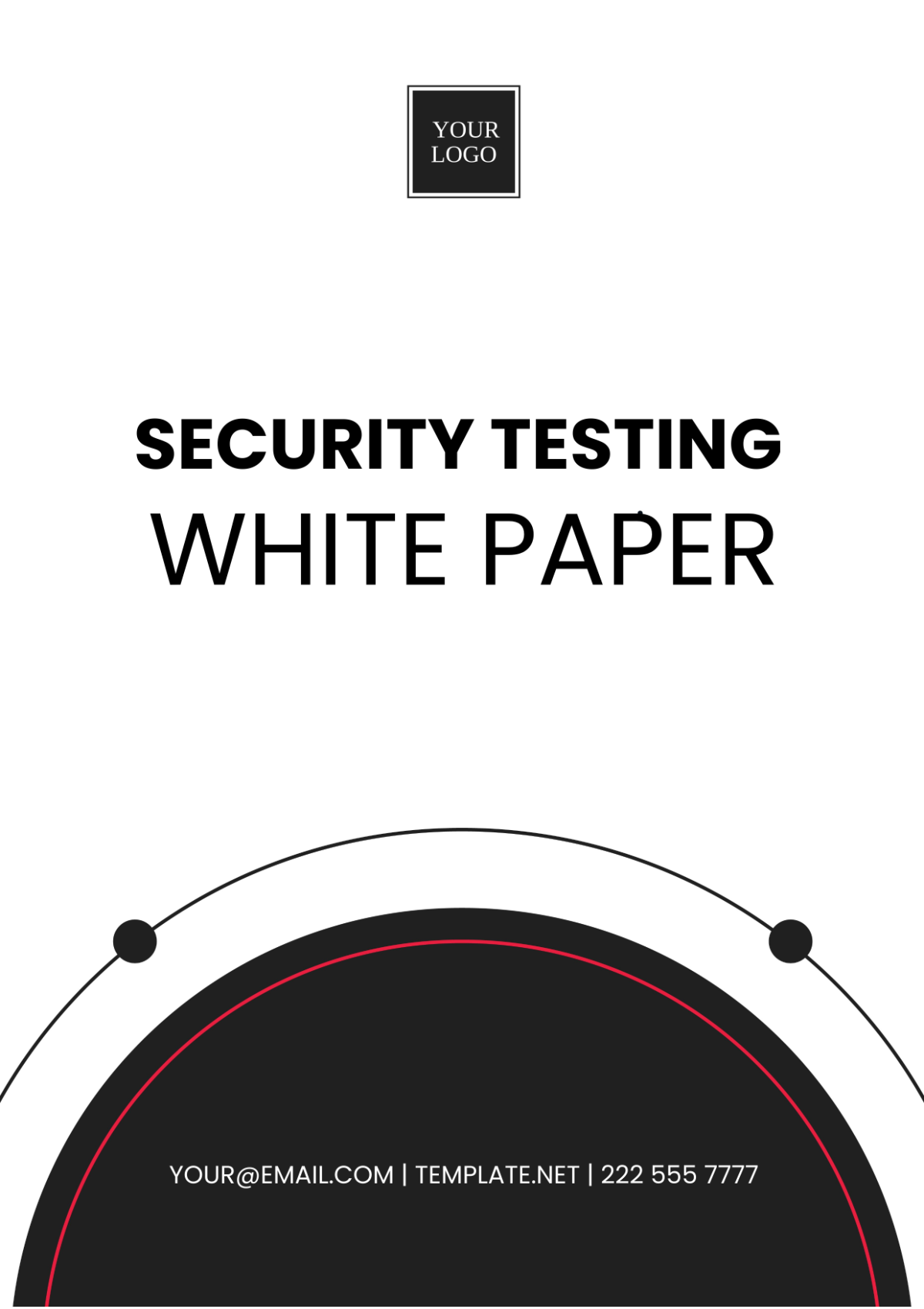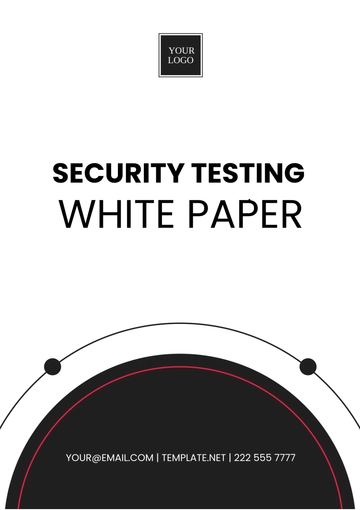Free Security Testing White Paper

Created by [YOUR NAME]
Organization: [YOUR COMPANY NAME]
Department: [YOUR DEPARTMENT]
Date: [DATE]
I. Introduction

A. Background and Context:
In today's digital landscape, cybersecurity threats are becoming increasingly sophisticated, posing significant risks to organizations' sensitive data and systems. As cyberattacks continue to evolve, the need for robust security testing measures has become paramount in safeguarding against potential breaches and vulnerabilities.
B. Purpose of the White Paper:
The purpose of this white paper is to provide a comprehensive guide to security testing, covering its definition, methodologies, best practices, and real-world case studies. By delving into these topics, readers will gain a deeper understanding of how to effectively assess and enhance their security posture.
C. Audience Identification:
This white paper is designed for IT professionals, cybersecurity experts, software developers, and anyone involved in ensuring the security of digital assets within organizations. It caters to both technical and non-technical audiences seeking insights into security testing strategies.
II. Understanding Security Testing

A. Definition of Security Testing:
Security testing refers to the process of evaluating a system, application, or network for vulnerabilities, weaknesses, and potential security threats. It involves various techniques and tools to identify and mitigate risks.
B. Importance of Security Testing:
Security testing is crucial for proactively identifying and addressing security vulnerabilities before they are exploited by malicious actors. It helps in ensuring the confidentiality, integrity, and availability of data and systems.
C. Types of Security Testing:
Vulnerability Assessment: A systematic approach to identifying and assessing vulnerabilities in software, networks, or systems.
Penetration Testing: Simulates real-world cyberattacks to assess the security posture and resilience of systems against external threats.
Security Auditing: Evaluates compliance with security policies, standards, and regulations to ensure adherence to best practices.
Risk Analysis: Assesses potential risks associated with security vulnerabilities and helps prioritize mitigation efforts.
III. Security Testing Methodologies

A. Overview of Methodologies:
Different methodologies are employed for conducting security testing, each with its own approach and focus. These methodologies encompass a range of techniques and strategies to assess and enhance security measures effectively.
B. Methodology 1: Vulnerability Assessment
Description: Vulnerability assessment involves systematically identifying, analyzing, and prioritizing vulnerabilities within a system or network. This methodology aims to uncover weaknesses that could be exploited by attackers.
Advantages:
- Provides a structured approach to identifying vulnerabilities.
- Helps prioritize remediation efforts based on risk assessment.
- Can be automated for continuous monitoring.
Disadvantages:
- Limited to identifying known vulnerabilities.
- May produce false positives or miss emerging threats.
- Requires regular updates to vulnerability databases for accuracy.
C. Methodology 2: Penetration Testing
Description: Penetration testing, also known as ethical hacking, simulates real-world cyberattacks to evaluate the security posture of systems. It involves actively exploiting vulnerabilities to assess the effectiveness of defense mechanisms.
Advantages:
- Provides a realistic assessment of security readiness.
- Identifies potential security gaps that may be missed by other methods.
- Helps validate the effectiveness of security controls.
Disadvantages:
- Can be time-consuming and resource-intensive.
- Requires skilled testers with expertise in various attack techniques.
- May cause disruptions to live systems if not conducted carefully.
IV. Best Practices in Security Testing
A. Preparing for Security Testing
Update systems and conduct risk assessments.
Define clear objectives and scope.
Choose appropriate tools and methodologies.
B. Execution of Security Testing
Develop a detailed test plan.
Document results and provide actionable reports.
Collaborate for efficient remediation.
C. Post-Testing Actions
Prioritize vulnerabilities and create a remediation plan.
Schedule regular security testing and continuous monitoring.
Learn from past tests and incorporate feedback for future strategies.
V. Case Studies
Case Study 1: [Company A]
Overview: Company A, a multinational financial institution, faced data breaches, phishing attacks, and compliance gaps.
Security Testing Approach: They conducted comprehensive security testing including vulnerability assessments, penetration testing, and employee training.
Results: Improved security posture, reduced vulnerabilities, increased employee awareness, and enhanced compliance.
Case Study 2: [Company B]
Overview: Company B, an e-commerce software development firm, faced SQL injection attacks, data breaches, and vulnerabilities in third-party integrations.
Security Testing Approach: They implemented regular vulnerability assessments, penetration testing, and code reviews to enhance software security.
Results: Identified and mitigated critical vulnerabilities, improved software security, and strengthened resilience against cyber threats. This led to a more secure e-commerce environment for their customers.
VI. Conclusion
In conclusion, security testing is crucial for identifying and mitigating cybersecurity risks. As technology evolves, automation and AI-driven tools will shape the future of security testing. We urge organizations to prioritize security testing and adopt best practices to strengthen their security posture.
VII. About the Author
[Your Name]
[Your Title]
[Your Company Name]
Contact Information:
Email: [Your Company Email]
Phone: [Your Company Number]
Website: [Your Company Website]
- 100% Customizable, free editor
- Access 1 Million+ Templates, photo’s & graphics
- Download or share as a template
- Click and replace photos, graphics, text, backgrounds
- Resize, crop, AI write & more
- Access advanced editor
Discover the Security Testing White Paper Template on Template.net for insightful security testing discussions. This editable template assists businesses in presenting testing strategies and outcomes effectively. Customize the white paper effortlessly using our AI Editor Tool, ensuring clear and comprehensive security testing insights. Simplify your security testing communication with this professional and user-friendly template.


















